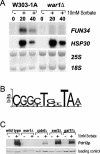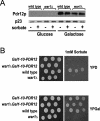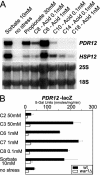Global phenotypic analysis and transcriptional profiling defines the weak acid stress response regulon in Saccharomyces cerevisiae
- PMID: 14617816
- PMCID: PMC338074
- DOI: 10.1091/mbc.e03-05-0322
Global phenotypic analysis and transcriptional profiling defines the weak acid stress response regulon in Saccharomyces cerevisiae
Abstract
Weak organic acids such as sorbate are potent fungistatic agents used in food preservation, but their intracellular targets are poorly understood. We thus searched for potential target genes and signaling components in the yeast genome using contemporary genome-wide functional assays as well as DNA microarray profiling. Phenotypic screening of the EUROSCARF collection revealed the existence of numerous sorbate-sensitive strains. Sorbate hypersensitivity was detected in mutants of the shikimate biosynthesis pathway, strains lacking the PDR12 efflux pump or WAR1, a transcription factor mediating stress induction of PDR12. Using DNA microarrays, we also analyzed the genome-wide response to acute sorbate stress, allowing for the identification of more than 100 genes rapidly induced by weak acid stress. Moreover, a novel War1p- and Msn2p/4p-independent regulon that includes HSP30 was identified. Although induction of the majority of sorbate-induced genes required Msn2p/4p, weak acid tolerance was unaffected by a lack of Msn2p/4p. Ectopic expression of PDR12 from the GAL1-10 promoter fully restored sorbate resistance in a strain lacking War1p, demonstrating that PDR12 is the major target of War1p under sorbic acid stress. Interestingly, comparison of microarray data with results from the phenotypic screening revealed that PDR12 remained as the only gene, which is both stress inducible and required for weak acid resistance. Our results suggest that combining functional assays with transcriptome profiling allows for the identification of key components in large datasets such as those generated by global microarray analysis.
Figures






Similar articles
-
A genetic screen identifies mutations in the yeast WAR1 gene, linking transcription factor phosphorylation to weak-acid stress adaptation.FEBS J. 2007 Jun;274(12):3094-107. doi: 10.1111/j.1742-4658.2007.05837.x. Epub 2007 May 17. FEBS J. 2007. PMID: 17509074
-
War1p, a novel transcription factor controlling weak acid stress response in yeast.Mol Cell Biol. 2003 Mar;23(5):1775-85. doi: 10.1128/MCB.23.5.1775-1785.2003. Mol Cell Biol. 2003. PMID: 12588995 Free PMC article.
-
The pdr12 ABC transporter is required for the development of weak organic acid resistance in yeast.EMBO J. 1998 Aug 3;17(15):4257-65. doi: 10.1093/emboj/17.15.4257. EMBO J. 1998. PMID: 9687494 Free PMC article.
-
Adaptive response and tolerance to weak acids in Saccharomyces cerevisiae: a genome-wide view.OMICS. 2010 Oct;14(5):525-40. doi: 10.1089/omi.2010.0072. OMICS. 2010. PMID: 20955006 Free PMC article. Review.
-
Carboxylic Acids Plasma Membrane Transporters in Saccharomyces cerevisiae.Adv Exp Med Biol. 2016;892:229-251. doi: 10.1007/978-3-319-25304-6_9. Adv Exp Med Biol. 2016. PMID: 26721276 Review.
Cited by
-
Activation of two different resistance mechanisms in Saccharomyces cerevisiae upon exposure to octanoic and decanoic acids.Appl Environ Microbiol. 2010 Nov;76(22):7526-35. doi: 10.1128/AEM.01280-10. Epub 2010 Sep 17. Appl Environ Microbiol. 2010. PMID: 20851956 Free PMC article.
-
Limosilactobacillus fermentum Limits Candida glabrata Growth by Ergosterol Depletion.Microbiol Spectr. 2023 Feb 21;11(2):e0332622. doi: 10.1128/spectrum.03326-22. Online ahead of print. Microbiol Spectr. 2023. PMID: 36802215 Free PMC article.
-
Response of Saccharomyces cerevisiae to stress-free acidification.J Microbiol. 2009 Feb;47(1):1-8. doi: 10.1007/s12275-008-0167-2. Epub 2009 Feb 20. J Microbiol. 2009. PMID: 19229485
-
Inactivation of the transcription factor mig1 (YGL035C) in Saccharomyces cerevisiae improves tolerance towards monocarboxylic weak acids: acetic, formic and levulinic acid.J Ind Microbiol Biotechnol. 2018 Aug;45(8):735-751. doi: 10.1007/s10295-018-2053-1. Epub 2018 Jun 6. J Ind Microbiol Biotechnol. 2018. PMID: 29876685
-
Metabolic impact of increased NADH availability in Saccharomyces cerevisiae.Appl Environ Microbiol. 2010 Feb;76(3):851-9. doi: 10.1128/AEM.02040-09. Epub 2009 Dec 18. Appl Environ Microbiol. 2010. PMID: 20023106 Free PMC article.
References
-
- Albertsen, M., Bellahn, I., Kramer, R., and Waffenschmidt, S. (2003). Localization and function of the yeast multidrug transporter Tpo1p. J. Biol. Chem. 278, 12820-12825. - PubMed
-
- Alexandre, H., Ansanay-Galeote, V., Dequin, S., and Blondin, B. (2001). Global gene expression during short-term ethanol stress in Saccharomyces cerevisiae. FEBS Lett. 498, 98-103. - PubMed
-
- Amoros, M., and Estruch, F. (2001). Hsf1p and Msn2/4p cooperate in the expression of Saccharomyces cerevisiae genes HSP26 and HSP104 in a gene- and stress type-dependent manner. Mol. Microbiol. 39, 1523-1532. - PubMed
-
- Bauer, B.E., Rossington, D., Mollapour, M., Mamnun, Y., Kuchler, K., and Piper, P.W. (2003). Weak organic acid stress inhibits aromatic amino acid uptake by yeast, causing a strong influence of amino acid auxotrophies on the phenotypes of membrane transporter mutants. Eur. J. Biochem. 270, 3189-3195. - PubMed
Publication types
MeSH terms
Substances
LinkOut - more resources
Full Text Sources
Other Literature Sources
Molecular Biology Databases
Research Materials

